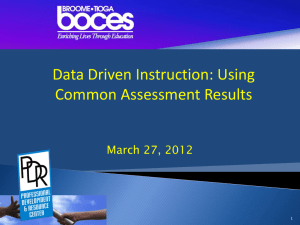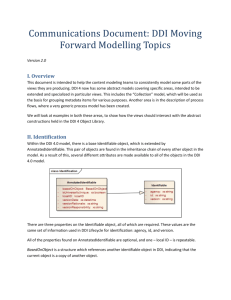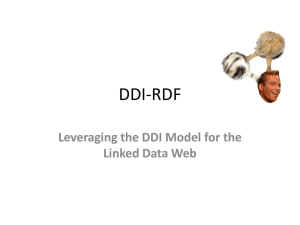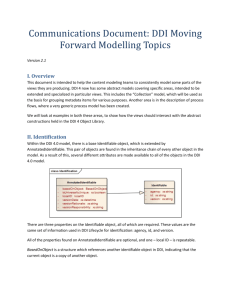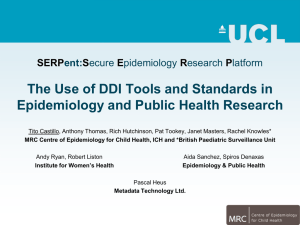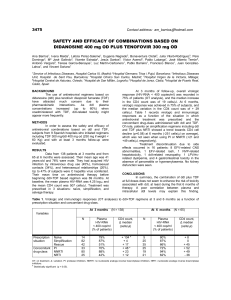Lang Li Department of Medical and Molecular Genetics
advertisement
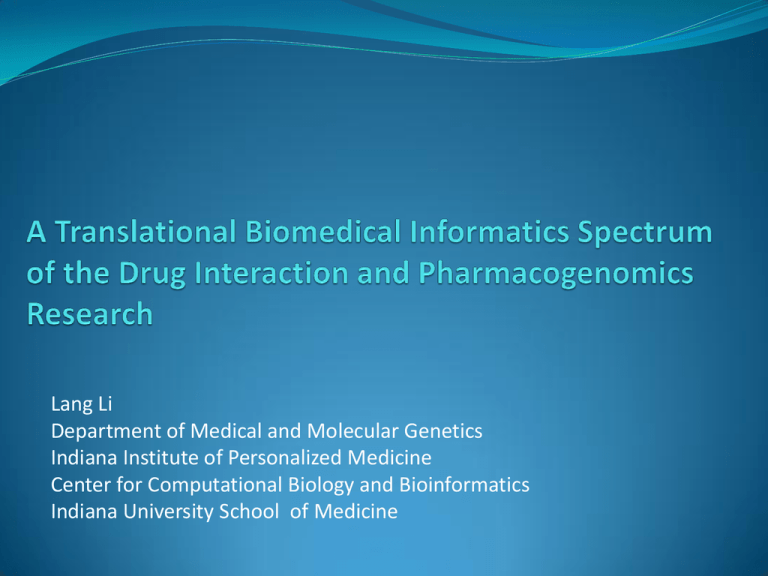
Lang Li Department of Medical and Molecular Genetics Indiana Institute of Personalized Medicine Center for Computational Biology and Bioinformatics Indiana University School of Medicine A Tamoxifen Story: background The selective estrogen receptor modulator tamoxifen (TAM) was first approved in 1977 by the FDA for the treatment of women with metastatic breast cancer and in ensuing years for adjuvant treatment of breast cancer. TAM is an established hormonal treatment for all stages of estrogen receptor (ER)-positive breast cancer and is widely used as a chemopreventive agent in women at risk for developing the disease. However, there is wide inter-individual variability in the clinical efficacy and side effects of TAM: some patients may be refractory to TAM, and a significant proportion of patients experience side effects that include hot flashes. (Osborne, 1998) A Tamoxifen Story: a pharmacokinetics idea 4-hydroxy-Tam is 30-100 times more potent than TAM in suppressing Estrogen-dependent cell proliferation. (Jordan et al. 1977, 1982) CYP3A, CYP2B6, CYP2D6 are responsible for TAM primary metabolism. (Lonning et al. 1992) There were evidences of secondary TAM metabolites, but their functions and metabolism pathways were not clear. (Stearns et al., 2003) A Tamoxifen Story: a pharmacokinetics idea CYP3A and CYP2D6 are responsible for TAM secondary metabolism. (Desta et al . 2004) Endoxifen is 10 times more potent than 4-hydroxy-TAM (Johnson et al. 2004) A Tamoxifen Story: pharmacogenetics and drug interaction hypotheses 1. Can CYP2D6 genetic polymorphisms predict endoxifen variation and breast cancer patient outcome? 2. Some of the breast cancer patients also take antidepressants, and many antidepressants are strong CYP2D6 inhibitors. Will these co-medications predict endoxifen variation and breast cancer patient outcome? Genetic and Drug Interaction Effect on Tamoxifen Metabolism Endoxifen/NDM plasma ratio 0.50 0.20 0.20 0.10 0.10 0.05 0.05 0.02 0.02 r²= -1 0 1 2 0.24 3 4 0.50 0.50 0.50 0.20 0.20 0.20 0.10 0.10 0.10 0.05 0.05 0.05 0.02 0.02 0.02 Endoxifen/NDM plasma ratio 0.50 r²= -1 -1 0 01 12 23 0.22r²= 0.43 43 4 Proposed CYP2D6 Gene Score System 1 CYP2D6 Gene Score CYP2D6 Proposed CYP2D6 GeneScore Score CYP2D6 Genetic Activity 0 -1 -1 System 0.20 0.10 0.20 sma ratio sma ratio Genetic /Drug- Inhibition Score 0.20 0.20 0.20 Borges et al. Journal of Clinical Pharmacology 2009 0.10 0.10 0.10 0.10 CYP2D6 Functional Genotype Predicts Patient Survival After Tamoxifen Treatment Goetz et al. 2005, JCO. CYP2D6 Functional Genotypes and Co-medications (CYP2D6 inhibitor) Predicts Patient Survival After Tamoxifen Treatment EM: CYP2D6 *1/*1, no CYP2D6 inhibitor IM: CYP2D6 *1/*4 no CYP2D6 inhibitor Time to Breast Cancer Relapse Relapse Free Survival PM: CYP2D6 *4/*4 or CYP2D6 inhibitor Disease Free Survival Overall Survival Goetz et al. 2007, BCRT. Traditional Pharmacology Approaches in Pharmacogenomics and Drug Interaction Studies in vitro studies (Human liver microsome, hepatocyte, recombinant system, and targeted tissue cells) that determine the drug metabolism pathways and drug inhibition effects, and sometime drug effects. Clinical studies that investigate genetic effect or drug interaction effect on drug exposure change or clinical endpoints. Read the literature!!! Read the literature!!! A Computational Biologist Approaches Read the literature Literature based discovery Clinical Study Large scale clinical database data mining in vitro studies System pharmacology based discovery Literature Based Discovery Drug A Drug B Enzyme E Existing Literatures Percha B., Garten Y., and Altman R. B., Discovery and explanation of drug-drug interaction via text mining. PSB, 2011. Segura-Bedmar I., Martinez P., and Pablo-Sanchez C. de. Using a shallow linguistic kernel for drug-drug interaction extraction. Journal of Biomedical Informatics, 2011, 44, 789-804. Segura-Bedmar, I., Martínez, P., de Pablo-Sánchez, C. (2011). "A linguistic rule-based approach to extract drug-drug interactions from pharmacological documents." BMC Bioinformatics 12(suppl 2): S1 Boyce, R., Collins, C., Horn, J., and Kale, I. (2009). "Computing with evidence Part II: An evidential approach to predicting metabolic drugdrug interactions." J Biomed Inform 42(6): 990-1003. in silico: DDI Prediction from PubMed Based Text Mining Pharmacokinetics and Drug Interaction Ontology Pharmacokinetics and Drug Interaction Corpus CYP substrates and CYP inhibitors Text Mining CYP enzyme based DDI prediction PK and DDI Ontology PK Corpus • Single drug in vivo PK studies: 60 • Single drug in vivo PG studies: 60 • in vivo drug interaction studies: 218 • in vitro drug interaction studies: 208 XML format is also available. Term Annotation: Term Sentence Sentences with Drug Name, Dose information, Enzyme Name, PK parameter, Units, Sample size, P-value, Mechanism, Adj word, Verb, Action work. Clear DDI Sentence (CDDIS) Vague DDI Sentence (VDDIS) C3 or C4 DDI IN-VIVO DDI IN-VITRO DDI DDI ADDI DEI ADD I ADEI Non-DDI NonDDI NonDEI PMID 20012601 DDI sentence Relationship and commend The pharmacokinetic parameters of verapamil were Because of the words, significantly altered by the co-administration of “significantly”, (Verapamil, lovastatin compared to the control. 20209646 lovastatin) is a DDI. The clearance of mitoxantrone and etoposide was Because of the fold changes were decreased by 64% and 60%, respectively, when less than 0.67, (mitoxantrone, combined with valspodar. valspodar.) and (etoposide, valspodar) are DDIs. 20012601 The (AUC (0-infinity)) of norverapamil and the Because of the words, “ not terminal half-life of verapamil did not significantly significantly changed”, changed with lovastatin coadministration. (verapamil , ovastatin) is a NDDI. 13129991 The mean (SD) urinary ratio of dextromethorphan The change in PK parameter is to its metabolite was 0.006 (0.010) at baseline and more than 1.5 fold but P-value 0.014 (0.025) after St John’s wort administration is >0.05. Thus, (P=.26) (dextromethorphan , St John’s wort) is an ADDI. 19904008 The obtained results show that perazine at its Because of words, “potent therapeutic concentrations is a potent inhibitor of inhibitor”, (perazine , CYP1A2) human CYP1A2. 19230594 is a DEI. After human hepatocytes were exposed to 10 Because of words, “not microM YM758, microsomal activity and mRNA induced” and “slightly level for CYP1A2 were not induced while those for induced”, (YM758, CYP1A2) CYP3A4 were slightly induced. and (YM758, CYP1A2) are NDEIs. Key Terms DDI sentences DDI Pairs Annotation Categories Frequencies Drug CYP PK Parameter Number Mechanism Change Total words CDDI sentences VDDI sentences Total sentences DDI ADDI NDDI DEI ADEI NDEI Total Drug Pairs 8633 3801 1508 3042 2732 1828 97291 1191 120 4724 1239 300 294 565 95 181 12399 Krippendorff's alpha 0.953 0.921 0.905 Drug Interaction Information Extraction Abstract Identification in vitro DDI Abstracts Clinical DDI Abstracts Sentence Identification DDI Extraction DDI Relevant Sentences DDIs, ADDIs, NDDIs DEIs, ADEIs, NDEIs DDI Extraction DDI Extraction Performance Datasets Precision Recall F-measure in vivo DDI Training 0.67 0.78 0.72 in vivo DDI Testing 0.67 0.79 0.73 in vitro DDI Training 0.51 0.59 0.55 in vitro DDI Testing 0.47 0.58 0.52 Predict Potentially Interacting Drug Pairs Using Text Mining of PubMed Abstracts Text mining of PubMed abstracts for in vitro drug metabolism studies involving major CYP450 isoforms using FDA recommended probes and HLMs or recombinant CYP450s 1A2 2A6 2B6 2C8 2C9 2C19 FDA recommended CYP2C9 inhibitors 2E1 … … + 2D6 Substrates Inhibitors 3A Predicted potentially+ interacting drug pairs FDA recommended CYP2C9 substrates 13,197 Predicted Potentially Interacting Drug Pairs Large Scale Database DDI Data Mining Tatonetti, NP, Denny, J.C., Murphy, S.N., Fernald, G.H., Krishnan, G., Castro, V., Yue, P., Tsau, P.S., Kohane, I., Roden, D.M., Altman, R.B. (2011). "Detecting drug interactions from adverse-event reports: interaction between paroxetine and pravastatin increases blood glucose levels." Journal of Clinical Pharmacology and Therapeutics 90(1): 133-142. Tatonetti, N. P., Fernald, G.H., Altman, R.B. (2012). "A novel signal detection algorithm for identifying hidden drug-drug interactions in adverse event reports." J Am Med Inform Assoc 19(1): 79-85. Tatonetti NP, Ye PP, Daneshjou R, Altman RB. 1. Data-driven prediction of drug effects and interactions. Science Translational Medicine, 2012 Mar 14, 4 (125). Observational Medical Outcome Partnership - Common Data Model Data Medication Data Diagnosis Lab Tests 2.2 Million De-identified Patient Data in the Indiana Patient Care Network (2004 – 2009) Drug Safety Outcome – Myopathy CDM Code (54 items) Myositis Muscle weakness Polymyositis Myoglobinuria Myositis unspecified [D]Myoglobinuria March myoglobinuria Idiopathic myoglobinuria Exertional rhabdomyolysis Rhabdomyolysis Traumatic rhabdomyolysis Non-traumatic rhabdomyolysis Rhabdomyolysis Myopathy, unspecified Myopathy, unspecified Myalgia and myositis, unspecified Muscle weakness (generalized) Polymyositis Myoglobinuria Rhabdomyolysis Other myopathies Toxic myopathy Antilipemic and antiarteriosclerotic drugs causing adverse effects in therapeutic use Myoglobinuria Rhabdomyolysis Polymyositis Muscle Weakness Myositis Muscle Weakness Myoglobinuria Myoglobinuria Polymyositis Polymyositis Myopathy toxic Myopathy toxic Muscle weakness conditions Myositis Myositis-like syndrome Myopathy Rhabdomyolysis Myositis Myositis-like syndrome Muscle weakness Generalised muscle weakness Generalized muscle weakness Myopathy Myopathy, unspecified Rhabdomyolysis Rhabdomyolysis-induced renal failure Myalgia and myositis, unspecified Antilipemic and antiarteriosclerotic drugs causing adverse effects in therapeutic use Myopathy unspecified Mylagia and myositis unspecified Muscle weakness Pharmaco-epidemiologic Study Design Baseline co-Meds (confounder) Baseline Exposure Window D1 + D2 D1 only D2 only No D1/D2 Myopathy Intermediate co-Meds (Modifier) Drug Exposure Window Causal Inference Propensity Score (Donald B. Rubin, 1981) Propensity score construction: multinomial logistic regression. Case control selection based on matched propensity score. Control group selection sensitivity analysis. Inverse Weighted Method (James M. Robins, 1999) Propensity score construction: multinomial logistic regression. Inverse weighted based regression Identify DDIs Associated with Increased Risk of Myopathy Using Electronic Medical Records Myopathy Risk Synergistic Effect Model Risk 1 0.03 + Risk 2 0.05 < Risk 12 ? 0.13 • Logistic regression • Adjust for age, sex, and medication frequency • Drugs that treated pain were removed. Loratadine Simvastatin Loratadine Only Only + Simvastatin • Bonferroni corrected Predicted CYP450 Pathways Based DDIs and Their Associations with Myopathy Risk (p-value < 0.01) Six Significant DDI Pairs drug 1 drug 2 myopathy myopathy combined Relative risk 1 risk 2 risk Risk P-value loratadine alprazolam 0.07 0.03 0.16 1.56 1.06E-09 loratadine duloxetine 0.14 0.03 0.28 1.56 7.43E-09 loratadine omeprazole 0.03 0.06 0.13 1.33 4.45E-07 loratadine simvastatin 0.03 0.05 0.13 1.60 4.75E-07 promethazine tegaserod 0.03 0.07 0.21 2.20 1.28E-05 loratadine ropinirole 0.03 0.12 0.31 2.05 1.27E-05 Removed drug pairs involving drugs used to treat pain, including: chloroquine, hydroxychloroquine, acetaminophen, oxycodone, hydrocodone, fentanyl, tizanidine Duke J., Han X., Wang Z., et al, 2012 PLoS Computational Biology Do the identified drugs inhibit CYP enzymes? CYP Enzyme Substrate Inhibitor Inhibitor concentration high to low 1 2 3 4 5 6 7 control 8 A B Test inhibitor C 1 D Test inhibitor E 2 F Test inhibitor G 3 H Positive inhibitor Estimate IC50 by fitting to 9 Fluorescent metabolite + + + Cofactors 10 Backgro und 11 12 37C for 15~45 min Summary of Metabolic and Inhibitory Profiles Metabolic pathway 1A2 2B6 2C9 2C19 2D6 IC50 3A 1A2 2B6 2C9 2C19 2D6 3A4 Duloxetine Loratadine Ropinirole Promethazine Simvastatin Tegaserod Not/Unknown Minor Major IC50 > 100 uM or ND 20uM < IC50 < 100 uM IC50 < 20 uM Metabolism Based Inhibition Interpretation of Six DDI Pairs Drug 1 Drug 2 pathways metabolism inhibition DDI Prediction loratadine alprazolam CYP3A4 major moderate Moderate loratadine duloxetine CYP2D6 minor strong Moderate loratadine simvastatin CYP3A4 major strong Strong promethazine tegaserod CYP2D6 major strong Strong loratadine ropinirole CYP3A minor strong moderate System Pharmacology: A trans-eQTL Analysis in identify a-SNPs for CYP2D6 Gene Expression Genetic Variation CYP2D6 Enzyme Activity SNP (Affymetrix) 204 Gene Expression 466 180 Enzyme Activity 488 Samples Publically Available SNP (Illumina) 207 Gene Expression 466 167 Enzyme Activity 488 Samples Publically Available Mediation Analysis A mediation analysis method was developed to assess the indirect SNP effects to CYP2D6 activity mediated by gene expressions. The mediated effect is estimated by product of coefficients Functional categories of Mediators Type cytokine growth factor ligand-dependent nuclear receptor translation regulator transmembrane receptor ion channel phosphatase G-protein coupled receptor peptidase kinase transporter transcription regulator enzyme other #genes (Affy) 5 5 6 6 11 13 15 17 31 52 76 80 245 382 #genes (illum) 7 11 8 10 14 18 22 20 39 63 127 113 365 609 What have we learned? The new translational biomedical information research paradigm works! Literature Based DDI Discovery EMR data based validation in vitro validation System pharmacology based discovery What is a drug interaction? Drug Interaction Evidences DDI changes Efficacy and ADE! DDI changes Drug ADME in vivo! DDI changes Drug ADME in vitro! Drug Interaction Mechanisms It is a drug target based DDI! It is a drug transporter based DDI! It is a drug metabolism based DDI! Why do we care about all the information? Only knowing the clinical effect of a DDI won’t help prevent the DDI. For example, polypharmacy. Only knowing the mechanisms of a DDI won’t be enough to understand its clinical impact. Even we understand both the mechanism and clinical effect of a DDI, we will have to worry about implementation. We all need each other! Wanqing Liu Medicinal Chemistry Purdue David A. Flockhart Clinical Pharm, IUSM Metabolism CYP CYP Jeffrey S. Elmendorf Physiology, IUSM Myocyte CYP Liver Portal vein CYP CYP Sara K. Quinney OBGYN, IUSM Urine Richard B. KimCYP Pharmacology UNIVERSITY of WESTERN ONTARIO Feces We all need each other! PK Ontology Drug Interaction Text Mining Myopathy Definition In CDM Drug Interaction Pharmacoepidemiology Study Design Lang Li Luis M. Rocha Jon Duke Xiaochun Li The true heroes! PK Knowledge Database DDI corpus Abhinita Subhadarshini M.S. Bioinformatics DDI Corpus DDI text mining Shreyas Karnik M.S. Bioinformatics Pharmacogenetics Corpus Santosh Philips Ph.D. Bioinformatics Transport Ontology Chienwei Chiang Ph.D. Bioinformatics EMR data processing PK data text mining Zhiping Wang Ph.D. Computer Science Ontology Construction in vitro validation Hengyi Wu Ph.D. Bioinformatics Xu Han Ph.D. Pharm and Tox DDI Graphical Presentation Hrishikesh Lokhande M.S. Bioinformatics Funding support are from NIGMS, AHRQ, and IUCRG. Thank you!
